Open AccessArticle
Assessing the Effects of Drought on Rice Yields in the Mekong Delta
by
Kim Lavane, Pankaj Kumar, Gowhar Meraj, Tran Gia Han, Luong Hong Boi Ngan, Bui Thi Bich Lien, Tran Van Ty, Nguyen Truong Thanh, Nigel K. Downes, Nguyen Dinh Giang Nam, Huynh Vuong Thu Minh, Suraj Kumar Singh and Shruti Kanga
Cited by 10 | Viewed by 2748
Abstract
In contrast to other natural disasters, droughts may develop gradually and last for extended periods of time. The World Meteorological Organization advises using the Standardized Precipitation Index (SPI) for the early identification of drought and understanding of its characteristics over various geographical areas.
[...] Read more.
In contrast to other natural disasters, droughts may develop gradually and last for extended periods of time. The World Meteorological Organization advises using the Standardized Precipitation Index (SPI) for the early identification of drought and understanding of its characteristics over various geographical areas. In this study, we use long-term rainfall data from 14 rain gauge stations in the Vietnamese Mekong Delta (1979–2020) to examine correlations with changes in rice yields. Results indicate that in the winter–spring rice cropping season in both 2016 and 2017, yields declined, corresponding with high humidity levels. Excessive rainfall during these years may have contributed to waterlogging, which in turn adversely affected yields. The results highlight that not only drought, but also humidity has the potential to adversely affect rice yield.
Full article
►▼
Show Figures





